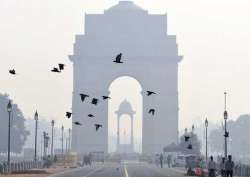Delhi-NCR air quality 'improves' to poor, but likely to worsen again
According to the officials, the reason for not enough improvement is only a slight dip in high level of pollutants already present in the air here, along with a hike in moisture and s drop in temperature.

The air quality of Delhi-NCR improved from "very poor" to "poor" on Tuesday even after 7.8 mm rainfall over past 24 hours, but is liken to worsen again, said officials.
According to the officials, the reason for not enough improvement is only a slight dip in high level of pollutants already present in the air here, along with a hike in moisture and s drop in temperature.
On Tuesday, the Air Quality Index (AQI) of Delhi at 4 pm was 219 or "poor" against 361 or "very poor" on Monday at the same time.
"There is improvement but not enough, as rains had reduced the density of effluents however the moisture content is high," Shambhavi Shukla, a researcher at the Centre for Science and Environment (CSE) and member of the Environment Pollution (Prevention and Control) Authority said.
According to experts, the mixing height of pollutants have increased a bit, which will however not help with improvement of air quality due to low wind speed and moisture levels.
"This is certainly not a reason to celebrate.. the air quality is still poor," Shukla added.
According to the forecast received by EPCA from India Meteorological Department (IMD), the scope of considerable improvement in the region's air quality are still low.
On December 7, even as the drizzling was way too low compared to that between Monday and Tuesday, the AQI of the national capital improved to "moderate" from "very poor" earlier, due to the meteorological conditions.
The most polluted regions across NCR, including Vasundhra in Uttar Pradesh's Ghaziabad, Anand Vihar in east Delhi, Sector 125 in Noida and Delhi Technical University (DTU) in north Delhi saw "very poor" air quality despite rains, with the major pollutants PM2.5 or particles with air with diameter less than 2.5 micrometers ranging between 123 to 194.
This is four to seven times the safe limit as per international standards.
The maximum temperature on Tuesday dropped to 21.7 degree Celsius, two notches below the season's average, against 27.2 on Monday.
However the minimum temperature increased to 13.8 degrees, five notches above the season's average, against 8.2 degrees on Monday.
According to IMD, the temperature drop is likely due to cumulative meteorological reasons.
"Wednesday would see minimum temperature of about 10 degrees, while the maximum is likely to hover around 21 degrees," an IMD official said.
The national capital saw low speed dry and cold north-westerly winds blowing at around 6 kmph, however despite this, humidity increased on Tuesday ranging between 71 to 100 percent.
"There are no chances of rains in Delhi-NCR as of Tuesday night," said IMD, adding that the high moisture would however lead to dense fog towards Wednesday morning.
This is a reason that air pollution is most likely to shoot back, according to the monitoring agencies.
According to System of Air Quality and Weather Forecasting And Research (SAFAR), Delhi-NCR air quality is set to deteriorate from Wednesday onwards, with aggregate 91 (poor) PM2.5 levels on Tuesday to 118 units or "poor" on Wednesday and 127 units on Friday, considered "very poor".